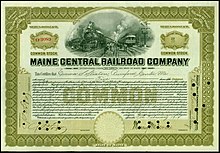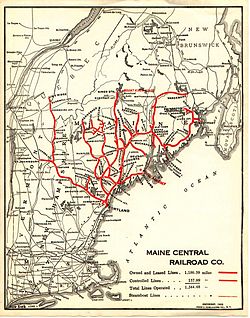Maine Central Railroad
The Maine Central Railroad Company (MEC) was an American railroad company . They operated about 2200 km of railroad lines and some ferries and shipping lines mainly in the southern half of the US state of Maine , but also in New Hampshire , Vermont and Québec . The company existed from October 28, 1862 to 1981. Today, the existing facilities belong to Pan Am Railways .
history
Takeover of other companies
The MEC was created when the Androscoggin and Kennebec Railroad and the Penobscot and Kennebec Railroad merged on October 28, 1862 . The entire Danville – Bangor line of the two companies had been built in the gauge of 1676 mm (5 feet 6 inches), as they connected in Danville to the network of the Grand Trunk Railway , which had also chosen this gauge. In 1871, the line was re-tracked to the standard gauge (1435 mm) used in the USA.
The main line was extended in 1871 from Danville by about 30 km to Yarmouth , where it joined the Portland and Kennebec Railroad (P&K). However, this had already been leased by MEC on May 12, 1870. With the Dexter and Newport Railroad on December 1, 1868, the Belfast and Moosehead Lake Railroad on May 10, 1871 and the Androscoggin Railroad on July 1, 1871, the MEC leased three smaller railway companies that operated the routes branching off from the MEC main line. The Androscoggin and the P&K finally became the property of the MEC on November 16, 1874 and were dissolved.
On April 1, 1882, the MEC leased the European and North American Railway , which operated the 191.9 kilometer main line from Bangor to the Canadian border at Vanceboro and two smaller branches to Stillwater and Howland . This company was finally incorporated in 1955. In 1883, two smaller companies followed which operated branch lines from Bangor, the Eastern Maine Railway to Bucksport on May 1 and the Maine Shore Line Railroad to Mount Desert Ferry on July 16. The latter was dissolved on October 22nd, 1888 and became the property of the MEC.
After New Hampshire , the MEC met before August 20, 1888, when they the Portland and Ogdensburg Railway leased (P & O). The approximately 177 km long route led from Portland through the White Mountains to the state border in Vermont near Lunenburg . In the same year, on December 13, 1888, the MEC also leased the Dexter and Piscataquis Railroad . The MEC only leased the St. Johnsbury and Lake Champlain Railroad to Swanton in Vermont in July 1912. In 1890 the MEC network reached Canada. The Upper Coos Railroad and the subsequent Hereford Railway , a total of 174 kilometers in length, branched off from the former Portland & Ogdensburg in Québec Junction and headed north to Lime Ridge in Québec.
The Knox and Lincoln Railway joined the MEC east of Bath and connected the Kennebec River with the port city of Rockland . The 78.8-kilometer line was leased on August 1, 1891 and finally bought on February 20, 1901. Another larger company could be leased on May 1, 1907. The Portland and Rumford Falls Railroad owned 167 kilometers of railroad tracks in western Maine.
The MEC bought three railway companies on July 1, 1911. The Sebasticook and Moosehead Lake Railroad owned a 24-kilometer branch line from Pittsfield to Mainstream and was extended to Harmony the following year . The Somerset Railway operated a 150-kilometer network from Oakland northwards. The 222-kilometer network of the Washington County Railway joined the east of the route of the former Maine Shore Line Railroad and connected this route with the Canadian Railroad at Calais .
However, the MEC also acquired narrow-gauge railways. In August 1911, the company owned the 166 km network of the Sandy River and Rangeley Lakes Railroad north of Farmington . In October 1912, the 34-kilometer Bridgton and Saco River Railroad followed . Both tracks were 2 feet (610 mm) wide .
In 1913, the MEC bought the Rangeley Lakes and Megantic Railroad , which operated a 17-kilometer route in the northwest of the state.
The decline and end of the MEC
At the end of the 1920s , the dismantling of the network, which was 2200 km in length, began. First the Sandy River and Rangeley Lakes Railroad was sold again in 1923, making it independent again. MEC's own ferry service was also given up during this time. The lease with the Belfast and Moosehead Lake Railroad expired on December 31, 1925 and was not renewed. From then on, the company operated its routes independently again. In February 1928, the MEC sold the almost entirely Canadian route of the former Hereford Railway to the Canadian Pacific Railway .
In the 1930s , the switch from steam to diesel locomotives began . In 1933, the MEC concluded with the Boston and Maine Corporation , which also operated an extensive network, had in Portland track connections to the MEC and in any case since the beginning of the 20th century owned the majority of shares in MEC, a " joint management " agreement on the Portland Terminal Railroad , which has been operated jointly since then.
On September 5, 1960, the last MEC passenger train ran, freight traffic was restricted in favor of road transport. During this time, many lines were closed in the MEC network. On December 17, 1974, the company sold the Mattawamkeag –Vanceboro section for 5.4 million US dollars to the Canadian Pacific Railway, which had been using this route since 1889. After the US Filter Corporation had bought MEC in 1980, the company was taken over a year later by the newly founded Guilford Transportation Industries (GTI), renamed Pan Am Railways at the end of March 2006. The Maine Central remains, however, as a subsidiary. The new owner streamlined a third of the network away, including the route to New Hampshire and Vermont and the route from Bangor to Calais.
In order to be able to conclude more favorable employment contracts for the company, Maine Central was leased to the subsidiary of GTI Springfield Terminal in the mid-1980s.
After the Maine Coast Railroad , which had taken over the routes from Brunswick to Rockland and Augusta in 1990, ceased operations in 2000, the Brunswick – Rockland route was sold on November 1, 2003 to the Morristown and Erie Railway , which has since been known as the Maine Eastern Railroad operates. Some branch lines of the former Maine Central are now closed.
statistics
On June 30, 1910, 201 locomotives, 187 passenger cars, 2 observation cars, 4 dining cars, 88 baggage, mail and express cars, 7030 freight cars and 532 company cars were in use on the railway network of MEC and its subsidiaries. In addition, the company had 2 ferry and 5 passenger ships. In fiscal year 1909/10, revenues of $ 8.9 million were offset by expenses of $ 6.1 million. Over 4 million passengers and 6.25 million tons of goods were transported.
literature
- George H. Drury: The Historical Guide to North American Railroads. 2nd edition. Kalmbach Publishing Co., Waukesha, WI 2000, ISBN 0-89024-356-5
Web links
- Page of today's operating company
- History of the Maine Railroad
- History of the Maine Central RR
- Chronicle of the MEC
Individual evidence
- ^ Poor's Manual of Railroads, 44th Annual Number. Poor's Railroad Manual Co., 1911, p. 46.





